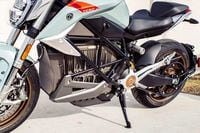Call me selfish, but I was reluctant to throw a leg over the 2020 Zero SR/F. There was not a single real reason as to why—maybe it was that my previous EV motorcycle experiences have left me wanting more performance and capability, or because modern-day superbikes have become my norm. Whatever the case, the Zero sat near the bottom of my priority list.
Then came the time that I had to burn some miles aboard the SR/F (I know, life’s hard as a road test editor). The problem was sister-publication MotorcyclistOnline.com editor Adam Waheed held the motorcycle hostage out of his love for the platform. His “I’ll bring it into the office tomorrow” dragged on for weeks. “Just one more day.”
cw’s affinity for Zero motorcycles stems back much further than Waheed’s hoarding of the SR/F, including the Zero S and SR models tested in 2013 and 2014. Both models gained respect among CW staff for their strong relative riding performance, but noted that additional refinement was needed to truly compete with traditional, internal combustion engine-powered motorcycles—a void left to be filled by the SR/F.
Zero Motorcycles introduced the 2020 model year SR/F as a “halo product,” showcasing the pinnacle of the company’s manufacturing capabilities and looking to lead EV motorcycle development. The SR/F is highlighted by a large-capacity ZF14.4 kWh lithium-ion battery and compact ZF75-10 motor, which boasts claimed class-leading power and impressive range measurements. As standard, the Zero SR/F comes equipped with a 3kW charger for $19,495, while our test mule was the $21,495 Premium model accessorized with a 6kW rapid charger, fly screen, heated grips, and aluminum bar ends.
To ensure an accurate test, we strapped the Zero to the in-house Cycle World dyno to ensure an accurate power reading, where the SR/F recorded 100.2 hp at 4,500 rpm and 146.5 pound-feet of torque at 1,200 rpm. What’s more compelling than the numbers is the curvature of the Zero’s dyno graph, highlighting the instantaneous torque delivery and an ultra-linear, rider-friendly power curve.
Around town, the Zero SR/F is a highly addicting commuter. The stealthy off-the-line acceleration in Sport mode—one of five selectable ride modes, including Eco, Street, Rain, and an additional custom user setting—will crush almost any automobile without drawing unneeded attention. In fact, the Zero SR/F logged a 0-to-60 time of 3.7 seconds and a 11.83-second 116-mph quarter-mile run. That’s faster than the inline-four-powered, middleweight 2019 Honda CB650R we tested earlier this year. Roll-on numbers reflect serious performance too, the SR/F ripping from 40–60 in 1.2 seconds and 60–80 in only 1.7 seconds, while topping out at a max speed of 124 mph.
Measured range of the Zero SR/F is highly dependent on riding habits (uh, throttle happy are you?) and scenarios. In order to establish fair measurements, I designated a 48-mile testing loop that reflects real-world riding, then lapped it on several occasions in the various riding modes. The lap included 18 miles of wide-open highway and the rest a mix of stop-and-go surface streets and canyon roads. Average battery consumption on the loop was 57 percent. Maximum range during testing was achieved by Bonnier Motorcycle Group Vice President Andy Leisner, who carefully covered 136 miles of mountain roads before completely emptying the tank… I mean, battery.
The charging experience of the SR/F was relatively effortless and straightforward, especially since the density of EV charging stations has significantly increased since last testing a Zero motorcycle. Level 2 charging stations offer the quickest rate of charge, providing a full 6kW capacity. Here, a 75-percent charge takes just over 1.5 hours—plenty of time to grab a cup of coffee, send a few emails, and make a couple of Instagram posts. The best part? Each charge was under $2. In comparison, the SR/F completed the same 75 percent in 3.5 hours on our in-house Level 2 charger, which is only capable of conducting 3kW per hour. A traditional three-pronged 110-volt household plug can also be used to charge the SR/F, but Zero claims a full charge will take eight hours.
Zero offers accessory chargers and battery packs to extract the most from the SR/F. An additional 6kW charger (bringing total charging capacity to 12kW) is offered for $2,400, cutting a 100-percent charge time to a claimed 1.5 hours at a competent station. An additional 3.4 kWh PowerPack will also soon be offered to SR/F owners, bumping claimed range to 201 miles in the city and 103 miles on the highway at 70 mph.
When escaping Southern California suburbia for the twisties, the SR/F proved to be a competent corner carver. Tipping the CW scales at 502 pounds ready to ride, the Zero requires a high amount of handlebar and footpeg input to tackle side-to-side transitions, slowly flopping into the corner. Once set, the SR/F’s solid chassis composure and top-shelf Pirelli Diablo Rosso III tires make quick work of the corners, while the Showa suspension components provide excellent damping characteristics after we dialed in the fork (more rebound damping).
Gripes? There aren’t many. While the relatively low 31.3-inch seat height allowed my 5-foot-7-inch frame to comfortably flatfoot the Zero, the saddle’s construction is overly stiff and uncomfortable for more than an hour of riding. That and a significant cost of entry make the Zero mostly unattainable in the current marketplace, slotting itself into a similar price point as the BMW S 1000 RR superbike.
Nonetheless, the Zero SR/F proves that the electric-motorcycle performance deficits of the past are being largely and quickly overcome. The Zero is genuinely fast and entertaining, yet impressively utilitarian. The lack of clutch and gearbox paired with medium-distance range makes this electric bike seriously useful as around-town transportation with the capability of tackling a few miles of twisties in between, while retaining a natural motorcycle riding experience.
Now, the Zero Motorcycles staff is here to take the SR/F back. Seriously, guys, just one more day.



















/cloudfront-us-east-1.images.arcpublishing.com/octane/RMCT2KVQBJHBZMRTSLOVPMOILU.jpg)

/cloudfront-us-east-1.images.arcpublishing.com/octane/K45KB2XHQVA65DX7VN4ZSMT2BI.jpg)
/cloudfront-us-east-1.images.arcpublishing.com/octane/BIVAK2SFIBDJJM25E7I5VU2FJE.jpg)
/cloudfront-us-east-1.images.arcpublishing.com/octane/FNHXQQ56BRD7TO4YIJ453PNG2M.jpg)
/cloudfront-us-east-1.images.arcpublishing.com/octane/OIKJC4JA3ZH7BMKUGWYKBIY5FA.jpg)
/cloudfront-us-east-1.images.arcpublishing.com/octane/MT2SAEWY6FDXFBYSLDE3AEFDTM.jpg)
/cloudfront-us-east-1.images.arcpublishing.com/octane/66UPKPYVURBPRCP5HXSN56MEMM.jpg)
/cloudfront-us-east-1.images.arcpublishing.com/octane/EOREGDSRKFDCRJC6K3EDVHBGCE.jpg)
/cloudfront-us-east-1.images.arcpublishing.com/octane/42RF63Q3LVCMBP3DGTWXFYSMOA.jpg)
/cloudfront-us-east-1.images.arcpublishing.com/octane/XNVY3EVWZFCEVPUGJGAN633LXE.jpg)
/cloudfront-us-east-1.images.arcpublishing.com/octane/2PLTVHXY7FDSPFHKU5CFOC43ZY.jpg)
/cloudfront-us-east-1.images.arcpublishing.com/octane/B6M3WTRLFZGNXBEATNXPVGBBD4.jpg)
/cloudfront-us-east-1.images.arcpublishing.com/octane/4CMH3FI73BEM5D6MFYX42FLDSQ.jpg)
/cloudfront-us-east-1.images.arcpublishing.com/octane/RIHAPYNWU5H3XAOXNOPRWCBTQA.jpg)
/cloudfront-us-east-1.images.arcpublishing.com/octane/HU4NUBCL3VAFZA75VYRCMAUHVM.jpg)
/cloudfront-us-east-1.images.arcpublishing.com/octane/OB43AZK7TRA6XLZL5WRDVW2TDA.jpg)
/cloudfront-us-east-1.images.arcpublishing.com/octane/5G44Y3FXWNFSTEQKCA355PXOPU.jpg)

/cloudfront-us-east-1.images.arcpublishing.com/octane/XRI4GTLCVBA5NESASCBIR5LYQI.jpg)
/cloudfront-us-east-1.images.arcpublishing.com/octane/EF7566PXARGMBAOMLWTECYL3LE.jpg)


